
Young Abstract Artists to Keep an Eye On
As an introduction to these profiles of ten emerging abstract artists we think deserve your attention, my editor asked me to comment a bit on the state of contemporary abstract art. This seemingly simple request has kept my mind swirling for several days. I have been writing about contemporary art for nine years, and specifically focusing on abstract art for more than a year and a half. Yet when asked to assess the state of it I am unsure exactly what to say. We live in a time of extreme anxiety for anyone who is paying attention to world events. And artists live in the same world as everybody else, so it is no surprise they are as affected by this anxiety as anyone. A multitude of forces are hard at work trying to write the future of this planet, and it often seems like few of those with the power to actually affect things agree on which direction civilization should go. But it is my opinion that abstract artists are uniquely positioned to influence our path. They are our visual poets. Their oeuvre can transcend barriers of language, culture, nationality, gender, race and economics. I agree with artists like Marcel Duchamp, who believe that viewers complete works of art by experiencing them. Artists are responsible for creating aesthetic propositions, but we are the ones responsible for determining what happens next. We can choose to be open to new ways of seeing. We can choose what has meaning, and what that meaning will be. To guide us along that path, contemporary abstract artists have all the same tools available to them as contemporary scientists, soldiers, tycoons and politicians. What they will do with those tools is the question they face every day. It is my continual hope that they will surprise me. The ten abstract artists we chose to focus on today work in a range of mediums and formats, and create work for many different reasons. Their diversity reflects the innumerable different paths each of us in this contemporary world is free to take. In my humble opinion, they are proof that the state of abstract art today is as alive as it has ever been, and as capable as ever of producing work that is meaningful, important, influential, and unexpected.
Iva Gueorguieva
Born in Sofia, Bulgaria, in 1974, Iva Gueorguieva earned her MFA from the Tyler School of Art in Philadelphia, and currently lives and works in Los Angeles, CA. Her aesthetic vision is one particularly suited to the urban environment. It involves disparate pieces coming together to participate in the creation of a new whole. Gueorguieva works across a range of different media, but focuses mostly on painting and sculpture. Her paintings combine elements of collage with a direct painterly intervention to create imagery that conveys complexity, motion, and a fair bit of chaos. Though essentially flat, they feel dimensional and encourage the viewer to be enveloped by the pictorial space. Like her paintings, her sculptures are also assembled from a slew of different mediums. To create them, Gueorguieva brings together pieces of her physical environment, such as concrete, metal, paper, plastic and paint, so the work possesses a sense of the place of its own origination. The abstract forms that are then assembled resonate powerfully with anyone familiar with the visual lexicon of a contemporary urban place.
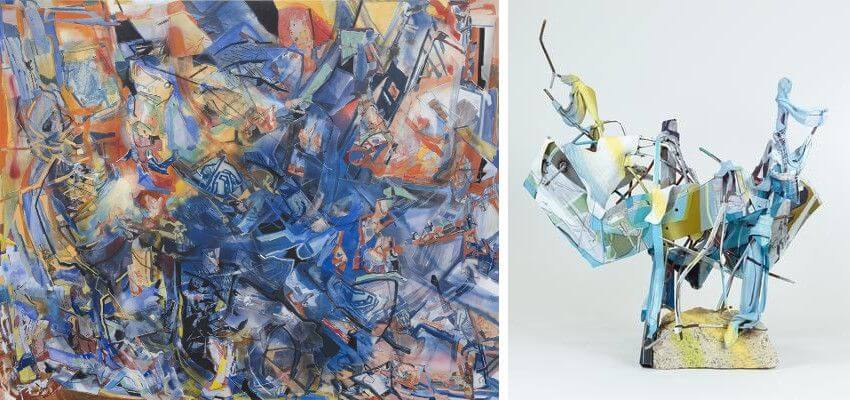 Iva Gueorguieva - Strata, 2015, Oil Stick on Canvas, © Sofia Contemporary and Iva Gueorguieva (Left) and Vanished Animal 5, 2015, Lithography, soapground, softground, hardground, drypoint, spitbite aquatint, waterbite aquatint, open bite on fabric with hand painting, spray paint, and oil stick on welded steel frame with steel panels, rebar, concrete, and epoxy clay, photo courtesy ACME Los Angeles, © Iva Gueorguieva (Right)
Iva Gueorguieva - Strata, 2015, Oil Stick on Canvas, © Sofia Contemporary and Iva Gueorguieva (Left) and Vanished Animal 5, 2015, Lithography, soapground, softground, hardground, drypoint, spitbite aquatint, waterbite aquatint, open bite on fabric with hand painting, spray paint, and oil stick on welded steel frame with steel panels, rebar, concrete, and epoxy clay, photo courtesy ACME Los Angeles, © Iva Gueorguieva (Right)
Holton Rower
The works of New York-born Holton Rower come into existence through a process of gradual accumulation. Like layers of sedimentary rock being laid down by time, Rower methodically pours monochromatic layers of paint onto a surface, allowing each layer to coalesce before pouring another layer on top. Eventually, as with mountains, the layers accumulate into substantial masses. Then with a blade Rower performs the task of the natural elements, carving away a final form. Whether presented on the wall or on the floor, these objects are inherently sculptural, and undeniably paintings. They are both industrial in nature and also the result of hard physical labor. They are formal objects of color, shape, form and texture, and also poetic statements about humanity and its ongoing intervention with nature. (Oh, and not that it is relevant to the power and presence of his extraordinary art, but Rower also happens to be the grandson of Alexander Calder.)
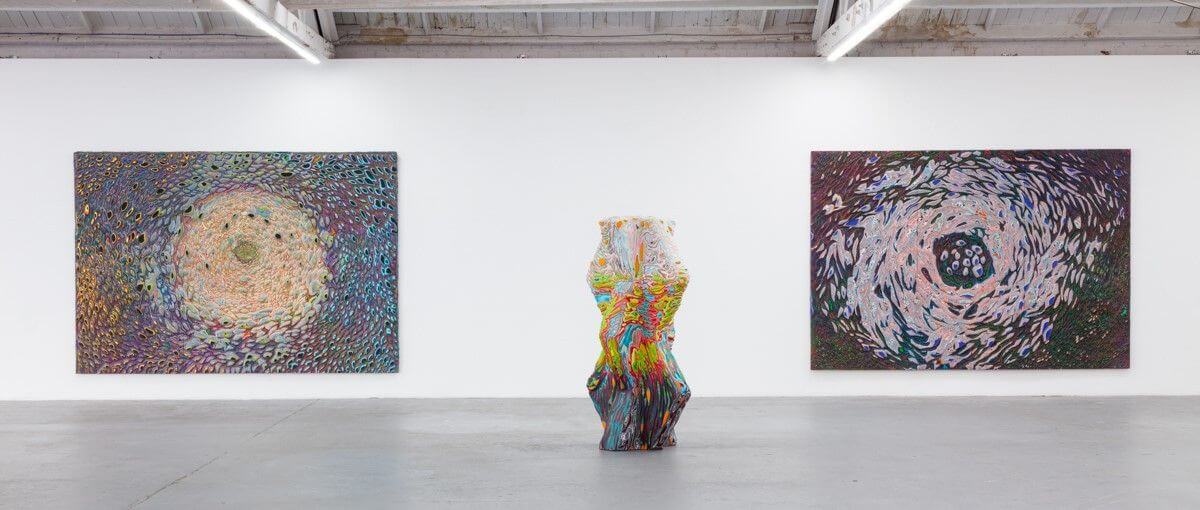 Holton Rower - Installation view at VENUS LA: The Idea is More Erotic Than the Act, 2016, paint on particle board (left), Victimless Crime Wave Reference, 2016, paint on particle board (center), I Pray It Gives You Hope, 2016, paint on particle board (right), © Holton Rower
Holton Rower - Installation view at VENUS LA: The Idea is More Erotic Than the Act, 2016, paint on particle board (left), Victimless Crime Wave Reference, 2016, paint on particle board (center), I Pray It Gives You Hope, 2016, paint on particle board (right), © Holton Rower
Hannah Whitaker
Like the Cubists of the early 20th Century, Washington, D.C.-born photographer Hannah Whitaker has uncovered thrilling aesthetic pathways to the fourth dimension. It sounds unbelievable, but her photographs are made the old-fashioned way: with nothing but a camera. By strategically controlling what part of the negative becomes exposed, she constructs images one piece at a time, sometimes taking multiple days to fully expose a single negative. The resulting images capture reality as it has transpired over time while moving through space. By combining this four-dimensional dynamism with formal abstract imagery, Whitaker has arrived at a unique aesthetic proposition, one that moves photography forward while also declaring the timeless value of its fundamentals.
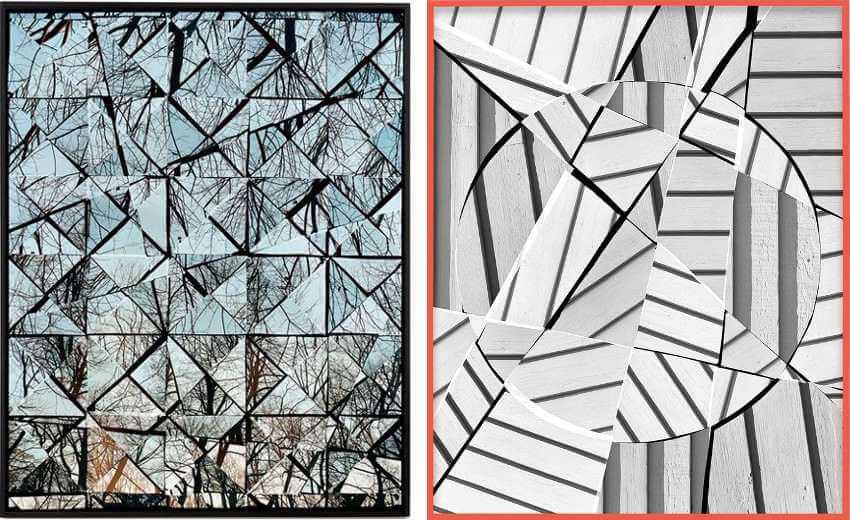 Hannah Whitaker - Barcroft Branches, 2014, archival pigment print (left), and Broadside 1, 2014, archival pigment print (right), © Hannah Whitaker
Hannah Whitaker - Barcroft Branches, 2014, archival pigment print (left), and Broadside 1, 2014, archival pigment print (right), © Hannah Whitaker
Ben Parker
Abstract origami artist Ben Parker is focused on the acts of discovery and experimentation. For some, the thrill of the ancient art of origami is to be able to witness the figure of an animal or a plant or a building emerge from the intricate folds of a single sheet of paper. For others, the thrill of origami lies in its potential for scientific discovery, as it seems to express the very foundations of the physical universe. But for Parker, the thrill is in discovering how to use the geometric folding techniques of origami to provoke abstract forms. His complex compositions create space while occupying it. They are both substantial and ethereal. They arise seemingly from nothing, and their meaning is unsure. That they are beautiful is undeniable; and for many viewers they are also undeniably profound.
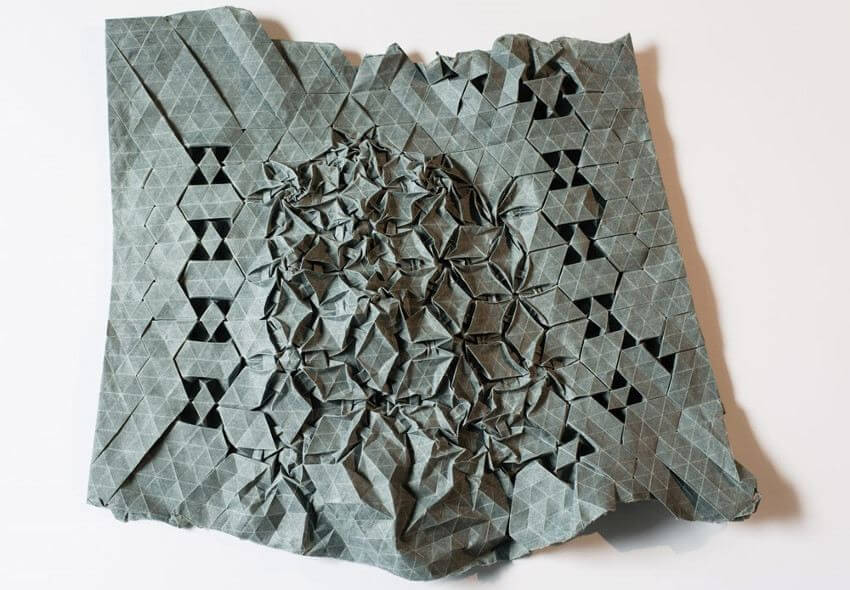 Ben Parker - Breached Containment, 2016, single sheet of paper, © Ben Parker
Ben Parker - Breached Containment, 2016, single sheet of paper, © Ben Parker
Ashleigh Bartlett
The work of Calgary-born artist Ashleigh Bartlett is founded on the acts of detachment and construction. Her collage paintings explore abstract compositions of color and form built out of layers of canvas, paper and paint. Her cut works achieve sculptural presences, assembled from the same materials as her collage paintings but lacking the surface support. As presented by Bartlett in these works, taking things apart and reassembling them can be read both as actions that reveal, as well as actions that conceal.
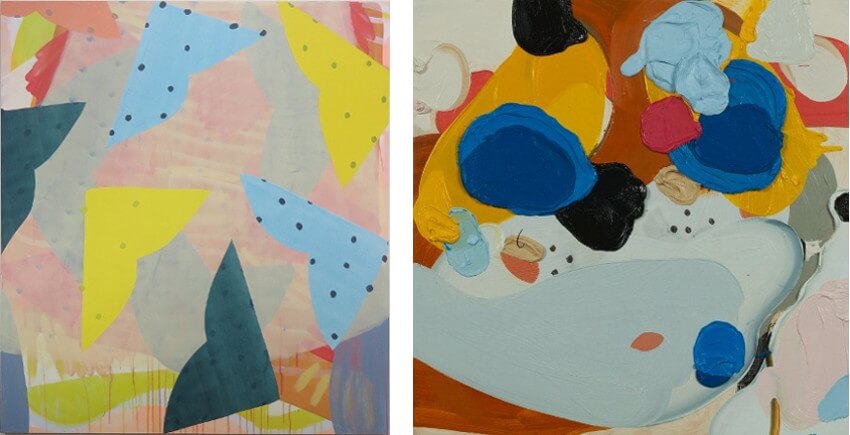 Ashleigh Bartlett - Surprise Wink, 2017, canvas, paper and acrylic on canvas (Left) and Snaggle, Oil on panel, 2011 (Right), © Ashleigh Bartlett
Ashleigh Bartlett - Surprise Wink, 2017, canvas, paper and acrylic on canvas (Left) and Snaggle, Oil on panel, 2011 (Right), © Ashleigh Bartlett
Pello Irazu
Multi-disciplinary artist Pello Artist was born in 1963 the Basque territory of Andoain, Gipuzkoa. His work is on the forefront of the contemporary aesthetic investigation of how objects negotiate with space. His installations frequently include murals painted directly onto the walls of the exhibition space. These murals speak in a formal conversation with his constructed objects, demonstrating the ways colors, lines and shapes transmogrify into forms. Of key interest to Irazu is the ongoing discussion of how viewers interact with aesthetic objects, and how they perceive of their relationship with the spaces such objects inhabit.
 Pello Irazu - Noli me tangere (mistrust) [Noli me tangere (la desconfianza)], 2009, Cast and welded aluminum pieces and screws (left), and Room Under, 1995, Plywood, vinyl paint, adhesive tape, and silkscreen on mirror (right) both from the collection of the artist, © VEGAP, Bilbao, 2017
Pello Irazu - Noli me tangere (mistrust) [Noli me tangere (la desconfianza)], 2009, Cast and welded aluminum pieces and screws (left), and Room Under, 1995, Plywood, vinyl paint, adhesive tape, and silkscreen on mirror (right) both from the collection of the artist, © VEGAP, Bilbao, 2017
Ramin Shirdel
Iranian artist Ramin Shirdel draws on his background in architecture to create architectonic, optically dazzling works of art. His sculptural paintings react with changing light conditions, casting shadows that alter the perception of their illusionary forms. Hidden in the works are poetic Farsi words with meanings such as love, truth, embrace, wave and masterpiece. The concrete, formal qualities of the pieces offer something aesthetically objective, while the ephemeral state of the image underlies the subjective meanings conveyed by the words.
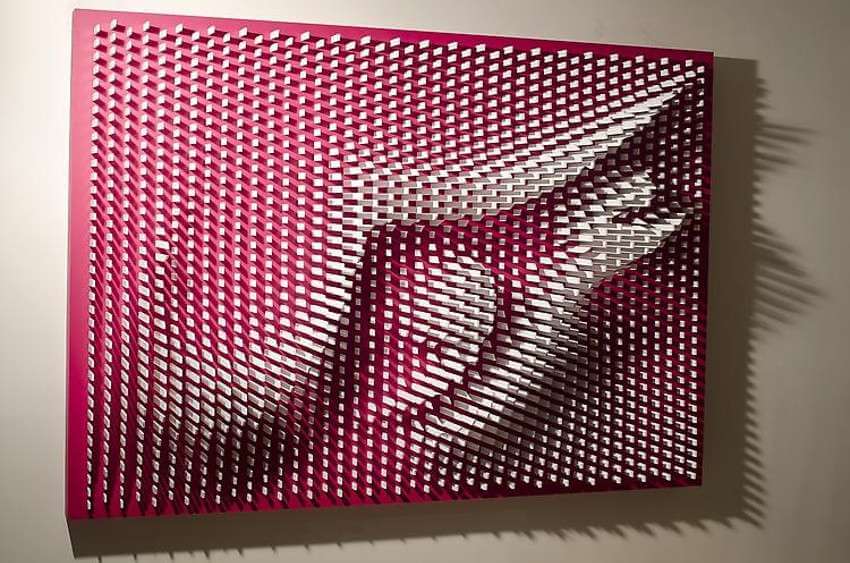 Ramin Shirdel - Aroos (Bride), 2013, Mixed media on wooden board, © Ramin Shirdel
Ramin Shirdel - Aroos (Bride), 2013, Mixed media on wooden board, © Ramin Shirdel
Afruz Amighi
For all practical purposes, the medium of Brooklyn-based artist Afruz Amighi is metal. She creates elaborate, delicate structures that resemble the spires of cathedrals, the pinnacles of minarets, or the points on the tip of a crown. But her hidden medium is light. When her creations are struck with light, they spring to life, drawing the eye to the ephemeral glitters on their surfaces while simultaneously casting dramatic, complex networks of shadows on the surrounding surfaces. The work speaks poetically about what is made visible and what remains hidden when all is illuminated.
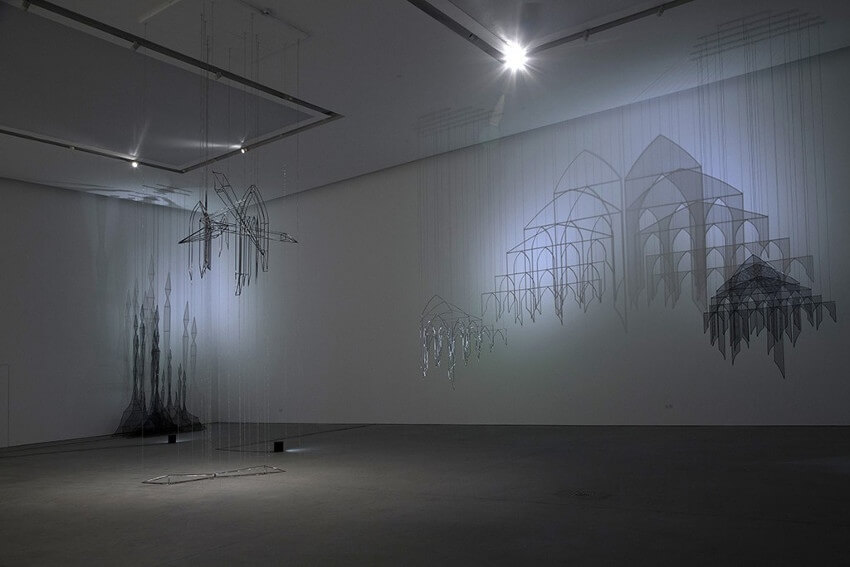 Afruz Amighi - Mangata, 2016, installation view, metal, chain, light, © Afruz Amighi
Afruz Amighi - Mangata, 2016, installation view, metal, chain, light, © Afruz Amighi
Artie Vierkant
New York artist Artie Vierkant gives an aesthetic voice to the ideas of authorship and control. His ongoing series called Image Objects involves the artist pulling images off the Internet, altering them in Photoshop then using them as surface elements for abstract objects that he constructs. It is difficult, however, to find photographs online of his finished image objects, because Vierkant also alters his exhibition shots in Photoshop, calling those pictures new works in their own right. Who owns the original source images, and thus might claim ownership of his altered image objects or exhibition images depends on how one looks at intellectual property. A point Vierkant also seems to be making is that the only truth of the work resides in its physical presence: looking at pictures of art online is not the same as seeing art in person. In addition to his Image Objects, Vierkant has also begun working with ground-up Monsanto seeds as an artistic medium. But one question this, and really all of his work, raises is how much importance viewers should give to the back-story of the source materials used in an artwork. Does it matter at all? Or is the aesthetic presence of the art object itself the only important thing? Do quasi-philosophical conversations have anything to do with art? Are they part of the art? Vierkant is doing his best to pose these questions in an aesthetically interesting way.
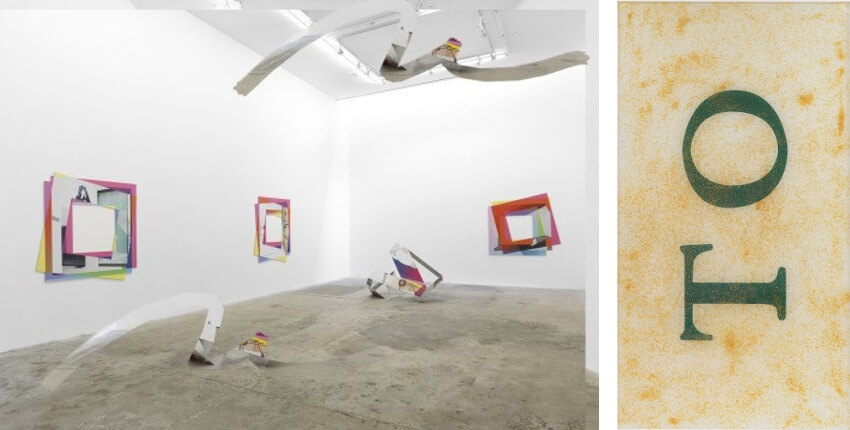 Artie Vierkant - Photoshopped installation view (left), and Plant expression constructs 2, Soybean MON89788, TO, Exploit (right), © Artie Vierkant
Artie Vierkant - Photoshopped installation view (left), and Plant expression constructs 2, Soybean MON89788, TO, Exploit (right), © Artie Vierkant
MadC
Former teen graffiti artist Claudia Walde, otherwise known as MadC, is transforming the way the fine art world interacts with street artists. MadC holds two degrees in graphic design and has authored numerous books. She is also world-renowned as a muralist, a field in which she has developed a distinct and visually stunning aesthetic position. She recently began evolving her visual language into a form that translates into formal, interior exhibition spaces. She has created stunning installations and also held exhibitions of her canvases, created with transparent spray paint layers that let underlying layers show through. She has even translated her work onto fashion objects, such as shoes.
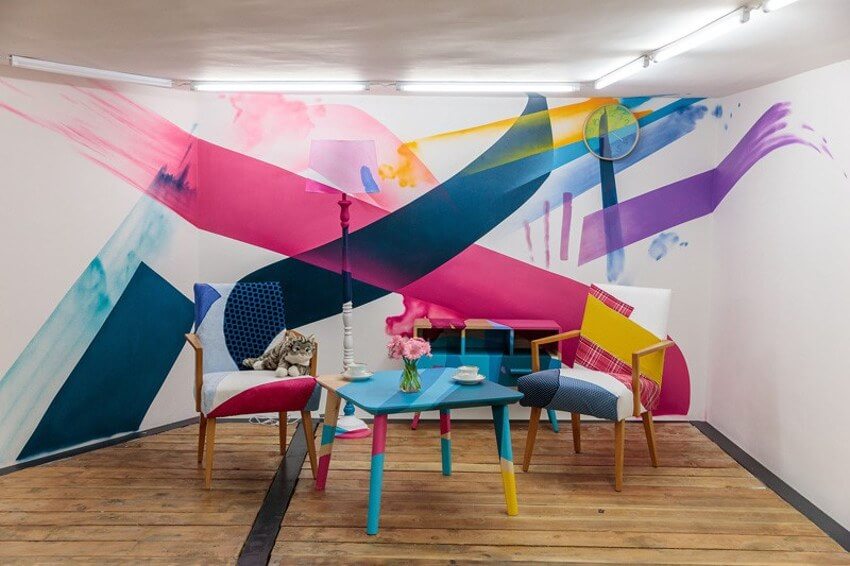 MadC - Home Sweet Home, 2016, installation, © MadC
MadC - Home Sweet Home, 2016, installation, © MadC
Featured image: Iva Gueorguieva - Desert Willow, 2016, Acrylic, oil, and collage on paper mounted on canvas, photo credits Ameringer McEnery Yohe, New York
By Phillip Barcio






